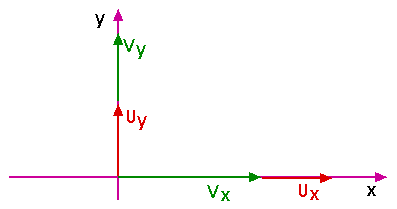

Vector Components
We can describe any vector V in terms of its magnitude V and its direction
. Here, we are measuring angle
from the positive x-axis. And angle
is positive for counter clockwise directions. Other coordinate systems may also be used; it is also common to measure angles from North.
We can also describe a vector V in terms of its components along the x- and y-axes,
V = Vx + Vy
How are these two descriptions related?
How are these two descriptions related? We have already seen that
Vx = V cos
Vy = V sin
for this coordinate system. We will use those relationships shortly.
Now consider a second vector U. It, too, may be expressed in terms of its components,
U = Ux + Uy
How can we add vectors U and V in terms of their components? That is, we want a resultant vector R that is
R = U + V
R = (Ux + Uy) + (Vx + Vy)
Since U = Ux + Uy and V = Vx + Vy, we may eliminate the vectors U and V from our diagram.
Now let us continue with our vector addition. Add the x-components together by themselves and then add the y-components together by themselves.
R = (Ux + Vx ) + ( Uy + Vy)
Rx = Ux + Vx
and
Ry = Uy + Vy
But look at these diagrams. While we have written Rx = Ux + Vx and Ry = Uy + Vy as vector addition equations, they are rather unusual vector equations. All the x-componets lie along the x-axis and all the y-components lie along they y-axis. So these particular equations are also true as scalar addition equations!

That is,
Rx = Ux + Vx
and
Ry = Uy + Vy
Finding the components of the resultant, then, has been reduced tor ordinary, commonplace, scalar addition!
Now that we know the components of the resultant, we can use them to reconstruct the resultant itself.
This will involve trig functions and the Pythagorean theorem.
Now that we have the idea, let's apply this numerical method of vector addition to the vector addition problem of the treasure map:
Vector A has only an x-component, so we can write
Ax = 5 paces
Ay = 0
"Northeast" means
= 45o, so
Bx = (7 paces) (cos 45o) = 5 paces
By = (7 paces) (sin 45o) = 5 paces
"West" means "to the left" or that the x-component is negative. The y-component is zero, so we have
Cx = - 10 paces
Cy= 0
"Northwest" means
= 135o, so
Dx = (7 paces) (cos 135o) = - 5 paces
Dy = (7 paces) (sin 135o) = + 5 paces
As always, watch the signs! They're important.
Now we're ready to add the component to find the components of the resultant. Vector notation is elegant shorthand notation. We write
R = A + B + C + D
but this means the following two ordinary, scalar equations:
Rx = Ax + Bx + Cx + Dx
and
Ry = Ay + By + Cy + Dy
For our example, these equations are
Rx = Ax + Bx + Cx + Dx
Rx = ( 5 + 5 - 10 - 5 ) paces = - 5 paces
or 5 paces to the west or to the "left" of the old oak tree (our origin).
and
Ry = Ay + By + Cy + Dy
Ry = ( 0 + 5 + 0 + 5) paces = 10 paces
or 10 paces north or "up" from the old oak tree ("up" meaning north, tho').
Now we can reconstruct the resultant R and its direction.
R = SQRT [ Rx2 + Ry2 ]
R = SQRT[ (- 5)2 + (10)2 ] paces
R = 11.2 paces
tan
= opp / adj = Ry / Rx
tan
= ( 10 ) / ( - 5 ) = - 2
= 116.6o
Remember, with our present coordinate system, this angle is measured from the positive x-axis. Let's talk about this angle itself. If you ask your calculator for the inverse tangent of - 2, it will probably tell you
= - 63.4. But look at the diagram. You know that can not be right! What happened? There are two possible solutions,
= - 63.4o
and
= - 63.4o + 180o
= 116.6o
You and your diagram must decide which to use. Calculators are great; just be sure you control the calculator rather than the other way round (and that is even more true -- and often more difficult -- with computers!)!


(c) Doug Davis, 2001; all rights reserved